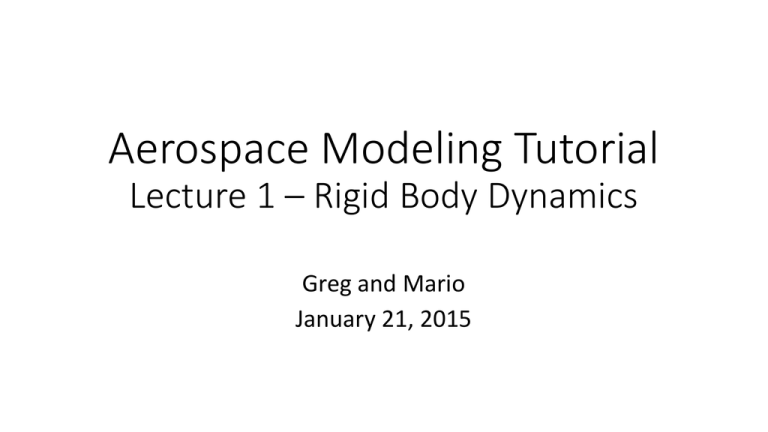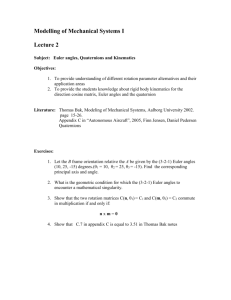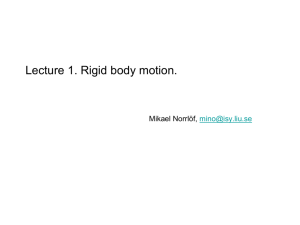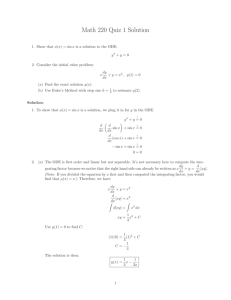Quick Access
advertisement

Aerospace Modeling Tutorial Lecture 1 – Rigid Body Dynamics Greg and Mario January 21, 2015 Reference frames 𝑥 𝑦 𝑧 North-East-Down: Body: 𝑥′ 𝑦′ 𝑧′ Relative rotation: 𝜔 Translational Dynamics 𝐹𝑛 𝑣𝑛 = 𝑚 𝑝𝑛 = 𝑣𝑛 𝐹𝑏 𝑣𝑏 = − 𝜔 × 𝑣𝑏 𝑚 Τ 𝑝𝑛 = 𝑅 𝑣𝑏 Rotational Dynamics 𝑇 = 𝐽𝜔 = 𝐽𝜃 (1 dimensional) 𝐽 ∙ 𝜔 = 𝜔 × 𝐽 ∙ 𝜔 + 𝑇𝑏 𝜔=𝐽 −1 [𝜔 × 𝐽 ∙ 𝜔 + 𝑇𝑏 ] (3 dimensional) Rotational sim 1 𝜔 0 = 0 0 1 0 0 𝐽= 0 2 0 0 0 3 Rotational sim 1 𝜔 0 = 0 0 1 0.1 0 𝐽 = 0.1 2 0.4 0 0.4 3 We know the angular velocity, but not the angle super easy 1 dimension 𝜔 = 𝑇/𝐽 𝜃=𝜔 How to model rotations – 1 dimension 𝑏𝑦 𝑢𝑥 cos 𝜃 = 𝑢𝑦 −sin 𝜃 𝑢𝑥 3.1 𝑢𝑦 = −0.4 𝑛𝑦 𝑏𝑥 θ 𝑣𝑥 3 𝑣𝑦 = 1 𝑛𝑥 sin 𝜃 cos 𝜃 𝑣𝑥 𝑣𝑦 How to model rotations – 3 dimensional First Idea: Euler angles (yaw, pitch, roll) Euler angles – how do we express the rotation? 𝑢𝑥 ? ? 𝑢𝑦 = ? ? 𝑢𝑧 ? ? ? ? ? 𝑣𝑥 𝑣𝑦 𝑣𝑧 How do we use this with our rigid body equations? 𝜔= −1 𝐽 [𝜔 × 𝐽 ∙ 𝜔 + 𝑇] ? How do we use this with our rigid body equations? 1 0 0 𝐽= 0 2 0 0 0 3 (Sorry for different time scales) How do we use this with our rigid body equations? 1 0.1 0 𝐽 = 0.1 2 0.4 0 0.4 3 (Sorry for different time scales) Euler angles – why don’t we use them? These are very nonlinear Major problem: Harry Ball Theorem (Every cow must have at least one cowlick) (You can’t comb the hair on a coconut) Q: What do we use instead of Euler Angles? A: Quaternions or Rotation Matrices! Quaternions in 15 seconds Very compact and elegant representation of attitude …which we will not discuss today Rotation Matrices a.k.a. Direction Cosine Matrices 𝑟11 𝑅 = 𝑟21 𝑟31 𝑟12 𝑟22 𝑟32 𝑟13 𝑟23 𝑟33 Convention: 𝑣𝑏 = 𝑅𝑣𝑛 How to rotate vectors from one frame to another? 𝑢1 𝑟11 𝑟12 𝑟13 𝑣1 𝑢2 = 𝑟21 𝑟22 𝑟23 𝑣2 𝑢3 𝑟31 𝑟32 𝑟33 𝑣3 Word to the wise: Everyone uses different conventions. Stick to one. Always check other people’s convention. Rotation Matrices a.k.a. Direction Cosine Matrices Derivative with respect to ω 𝑟11 𝑟21 𝑟31 𝑟12 𝑟22 𝑟32 0 𝑟13 𝑟23 = −𝜔𝑧 𝜔𝑦 𝑟33 𝜔𝑧 0 −𝜔𝑥 −𝜔𝑦 𝜔𝑥 0 𝑟11 𝑟21 𝑟31 𝑟12 𝑟22 𝑟32 𝑟13 𝑟23 𝑟33 DCM sim 1 0.1 0 𝐽 = 0.1 2 0.4 0 0.4 3 DCM sim 1 0 0 𝐽= 0 2 0 0 0 3 What makes DCMs hard? Hard to visualize • Solution: convert to Euler angles before plotting Must be initialized right-handed and orthonormal • Easiest solution: initialize to identity • Easy solution: initialize as Euler angles then convert to DCM. • If initial angle is free/unknown, use hard solution: enforce orthonormality as a constraint 𝑅1 = 𝑅2 Matching conditions have 9 equations and 3 degrees of freedom • Solution: Enforce small relative rotation = 0 𝑒𝑥Τ 𝑒𝑥 = 1 𝑒𝑥Τ 𝑒𝑦 = 0 𝑒𝑦Τ 𝑒𝑦 = 1 1 0 𝑅1Τ 𝑅2 = 0 1 0 0 𝑟11 𝑟21 𝑟31 𝑟12 𝑟22 𝑟32 𝑒𝑥Τ 𝑟13 𝑟23 = 𝑒𝑦Τ 𝑟33 𝑒𝑧Τ 0 𝑒𝑥 × 𝑒𝑦 - 𝑒𝑧 = 0 0 Only enforce this at one time point! Doing this more than once destroys LICQ! 0 0 1 Only enforce these three IMPORTANT: Also enforce diagonal elements positive Homework 1: Reproduce these plots 1 𝜔 0 = 0 0 (Sorry for different time scales) 1 0.1 𝐽 = 0.1 2 0 0.4 0 0.4 3 Homework 2: Match two simulations with different states 0.3𝑡 + 0.1 sin 3𝑡 𝐹𝑛 (𝑡) = 0.4𝑡 + 0.2 sin 4𝑡 0.5𝑡 + 0.1 sin 5𝑡 1.5 sin 2𝑡 𝑇𝑏 (𝑡) = 2 sin 1𝑡 sin 0.5𝑡 1 0.1 0.3 𝐽 = 0.1 2 0.2 0.3 0.2 3 𝑥1 = 𝑝𝑛 𝑣𝑛 𝜔 𝑅 𝑥2 = 𝑝𝑛 𝑣𝑏 𝜔 𝑅 0 𝑝 0 =𝑣 0 =𝜔 0 = 0 0 1 0 0 𝑅(0) = 0 1 0 0 0 1 Homework 3: minimum torque satellite de-tumble Multiple shooting with 200 timesteps, rk4 integrator Objective= 𝑘 𝑇𝑘 1 0.1 0.3 𝐽 = 0.1 2 0.2 0.3 0.2 3 Τ 𝑇𝑘 0.07 0.46 0.88 𝑅(0) = −0.89 −0.37 0.26 0.45 −0.80 0.39 2 𝜔 0 = 1 4 1 0 0 𝑅(6) = 0 1 0 0 0 1 0 𝜔 6 = 0 0 Homework 4: OPTIONAL BONUS QUESTION same problem as homework 3, but in minimal time Objective is now end time Add bounds on the control: −2 2 −2 ≤ 𝑇𝑘 ≤ 2 −2 2





